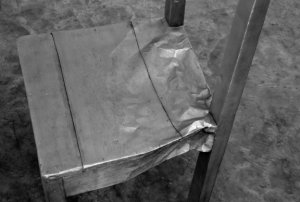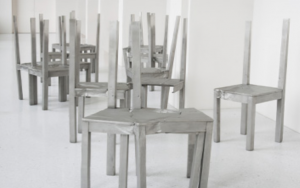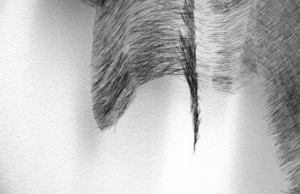Born in Bogota, Columbia in 1958, renowned artist Doris Salcedo completed her BA Universidad de Bogotá Jorge Tadeo Lozano in 1980 and continued on to earn an MA from New York University in 1984. She then moved back to Colombia and began teaching at the Universidad de Bogotá. Her experiences as a Colombian are extremely influential to her work, as significant themes in her work are memory, violence, loss, and trauma in war torn and developing countries. Her work is substantially influenced by the political turmoil in her country, Salcedo using personal testimonies of people who have experienced violence due to the Colombian Civil War in her work. Salcedo makes connections between absence and loss, and invokes a sense of empathy through conceptual installations, which while often times large, lend a certain sense of intangibility due to their abstract and seemingly mundane qualities.


“A Flor de Piel started with the simple intention of making a flower offering to a victim of torture, in an attempt to perform the funerary ritual that was denied to her.” – Salcedo
Salcedo’s work comments on the experience of loss as a result of political violence and trauma, specifically that has stemmed from the civil war in Columbia. Her works consist of installations, sculptures and public interventions, comprising of relatively mundane materials such as wooden furniture, concrete, rebar, clothing, grass, and rose petals. Her use of common and domestic materials addresses the commonality and relatability of loss, as well as the tendency for trauma to become a normalized part of life in areas that face marginalization. This speaks to the concept of an everyday object becoming a dysfunction symbol of pain, and occasionally even healing. She transforms seemingly average and comforting objects into objects that symbolize pain. Many of her pieces focus on the substantialization of human loss into something more tangible, attempting to regain individual dignity, and presence in the cases where the human body is absent. Often times, her work is a stand in for the body, and has anthropomorphic qualities. This is evident in Thou-less (2001-02), as her use of furniture, more specifically chairs, add body in the form of legs, feet, and a back. The crumpled form of the metal speaks to the fragility of human bodies and life.


Thou-less (2001-02)
Discusses the presence, absence, strength and weakness of the human body-certain parts of chairs are missing, and others are deformed.
Salcedo’s Disremembered consists of three sculptures which comprise of woven raw silk and 12,000 needles each. Inspired by Chicago gun deaths, the work speaks to the difficulty of expressing grief and mourning in today’s world. Additionally, it addresses the lack of empathy that saturates public life, in that a person’s pain is stigmatized and misunderstood by others, only adding to their burden. Along with empathy and loss, another large theme in relation to this piece is memory. Due to semi-present state and translucent quality of the work, it can be interpreted as a fading memory. The interweaving of the solid, shiny, needles and the nearly transparent silk thread cause a sense of illusion where the piece seems to shift with the viewer’s proximity to it.


The finer details of the sculpture appear to change, sometimes becoming invisible, embodying a sense of paradox. This reinforces the concept of collective inability to perceive loss, as the piece changes with perspective. The use of needles in such a delicate way causes the viewer to question whether the piece is inherently violent and intended to harm, or to protect, mimicking the sense of confusion/agitation that comes with death, loss and mourning. The fragility of the piece adds to the beauty, contrasting its dangerous nature. Additionally it addresses the fragility of life and symbolizes the stigmatization and lack of empathy when it comes to grief and mourning.

“Disremembered”- The pain is only evident with proximity- parallel for collective perception and acceptance of grief.
Ultimately, Salcedo’s work initiates questions of immortalization through memorialization, or even acknowledgment of violences done. Is her acknowledgment of these victims, regardless of lack of personal imagery, a mode of immortalization- is immortalization of pain or grief equatable to immortalization of the indivuaual, or does defining them by their tragedies take personhood away from them? How does her charging of domestic objects, along with laborious process involving these objects, change (force discussion about) narratives around memory, loss, grief, and acceptance of normalized violences?
Video: https://www.theguardian.com/cities/video/2016/jul/26/artist-doris-salcedo-bogota-forces-work-brutal-video
Works Cited
“Doris Salcedo.” Pbs.org. Art 21, n.d. Web. 26 March. 2017.
Finkel, Jori. “Doris Salcedo, Whose Art Honors Lives Lost, Gets a Retrospective in Chicago.” New York Times. New York Times, 11 Feb. 2015. Web. 26 March. 2017..
“Http://artdaily.com/news/47584/Moderna-Museet-Malmo-Presents-Colombian-Artist-Doris-Salcedo-with–Plegaria-Muda-#.VgPQhLQ-DEY.” N.p., n.d. Web.
Recent Comments